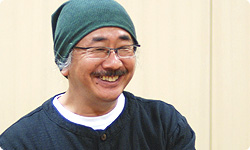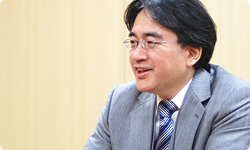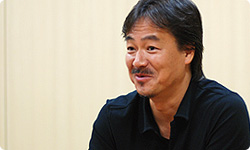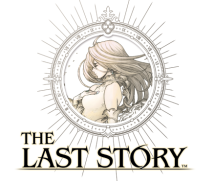1. Fate Works in Mysterious Ways
Editor’s note:
the original interview was published on 17th August, 2010.
Today, I am joined for the third time by Sakaguchi-san, along with Nobuo Uematsu, who was responsible for the music in The Last Story. Now, the pair of you have worked together for a long time. Could you tell me how your collaboration came about? How did you first meet?
Well, I used to live in a place called Hiyoshi, in Yokohama, and every night I would go for a drink with a group of aspiring writers, musicians, calligraphers, people like that. It was through them that I met a woman who worked at Square1 and was introduced to that company. Square were based in Hiyoshi at the time, and that’s how I met Sakaguchi-san, who was the boss. 1 Hironobu Sakaguchi: oversaw the Final Fantasy series (from FF I to FF X-2) at Square, now Square Enix
I was working as a director at the company, which at the time was made up entirely of part-time staff. We were in the middle of developing our debut title, The Death Trap2, and were looking for someone to work on the music. 2 The Death Trap was a PC adventure game released only in Japan. It was the first title developed by Square, and Hironobu Sakaguchi was responsible for the game’s scenario.
So you were brought together by fortuitous timing.
Precisely. I think Uematsu-san had a part-time job in Hiyoshi at the time, right?
Yes, I did. I was working at a cassette rental shop, the kind of place people today can’t imagine ever having existed. (laughs) Sakaguchi-san began to pop in from time to time, and I would give him my demo tapes. Then I happened to bump into him one day in town, and he said: ‘Square is going to be a fully independent company. Do you want to join?’ I gave him my answer right there and then: ‘Yes, I do!’ (laughs)

How long was that after you had first met?
About a year, I’d say.
I was really lucky, as I didn’t have to do a company entrance exam! (laughs)
I don’t think any of us would have been able to do an entrance exam back then! (laughs)
I joined HAL Laboratory3 after working there part-time, so I never had to go through a recruitment process, or take any exams either! (laughs) I’d say that, back then, most software developers operated in the same way. A group of people would come together who felt they could create something interesting together, and that would then evolve into a company. There was no need to go through any formal procedures. 3 HAL Laboratory, Inc. is a Japanese video game developer which created the Kirby and Super Smash Bros. series. After the company was founded in 1980, Satoru Iwata worked there part-time while studying at university, and joined as a full-time staff member after graduation.
I don’t think I ever sent in a CV either.
No, I don’t think you did. In fact, now you mention it, I don’t think I’ve ever seen your CV! (laughs) I only learned later that Uematsu-san had studied English literature.
Hey! Don’t tell everyone that! (laughs)
It’s a shocking revelation! (laughs) How did you end up getting involved in music?
I was just a regular music fan. I wasn’t into classical music so much. I’d listen to rock and pop on the radio late at night, and imagine having a career where I was involved in music. That was when I was in secondary school, and it felt like an impossible dream. I made demo tapes and sent them to various places, but it isn’t an industry where you can just walk into a job. So when I met Sakaguchi-san, I hadn’t studied music formally. That’s why I feel incredibly lucky to have been given this job. I feel that fate was somehow at work.
I spoke to Koji Kondo-san4 recently about Mario’s twenty-fifth anniversary. He spoke about having had the opportunity, on the second title he worked on, to create the Super Mario Bros. theme, which everyone is now familiar with. He also spoke about feeling like fate was at work. You talk about being lucky, Uematsu-san, as you were in the right place at the right time, but perhaps it was also fate working, in its mysterious way. 4 Koji Kondo has been responsible for creating the music in many video games, including the Super Mario Bros. and Legend of Zelda series. He works within the Entertainment Analysis and Development (EAD) division at Nintendo.
You can study at a specialist college now, but back then, making music for video games wasn’t an established career choice. I get the sense that people who were struggling to make a living through music ended up working in video games. I sense that there may have been a lot of people in this industry who had wanted to work in fields such as film, but their dreams hadn’t quite worked out. This meant that, back then, there was a real desire to create something fresh and new in the medium of video games, to make up for the fact that things perhaps hadn’t gone as originally planned.
In a mere two decades, the range of means available to express musical ideas has expanded greatly, and each time the technology changes, you can explore ways to fully harness that potential. But creating audio content for video games in the early days meant working within strict limitations. How did you feel, as someone who had aspired to make music, to be working within those tight limitations?
I thought of my job as a sort of game in itself. (laughs)
Ah, I know what you mean! (laughs)

At the time, the Famicom had a three-note limitation5, so writing music was like trying to solve a puzzle. I actually rather enjoyed it. 5 The Famicom was only capable of playing three notes at the same time, incorporating both game music and sound effects.
I suppose it was those people who found working within those limitations enjoyable who went on to achieve real results within the world of video game music. I’d say there are those who are suited to it, and those who are not. While some resented the restrictions of having just three notes to use, others relished the challenge.
You might only have had three notes, but you could use two of those notes to create a kind of chorus effect.
We’d try out all sorts of things, such as subtly adjusting the frequencies to create a sound with more depth. There were a lot of different software developers making games for the Famicom, and each one would have their own approach to sound.
The tone of the sound would vary between developers, wouldn’t it?
Some software was using such incredible sound sources that I’d wonder how they had managed to create a sound like that.
Speaking of amazing sounds, Konami would use a tone-generating chip that was actually inside the cartridge. Each developer had their own approach, meaning there was a real range of sounds being used.
Ah, I remember that. So they were using a chip, were they?
I remember when I first found that out, I thought that was cheating a bit! (laughs)
What impression did you get of Uematsu-san when you first met him?
Well, I don’t think he’s really changed. He has always been a very frank, open person.
Except I was much younger. I was still in my twenties back then.
But you haven’t really changed that much. You are just yourself, without any airs or graces, or pretensions. I remember thinking that this guy would be able to write music with heart. But having said that… Well, it wasn’t all plain sailing at the start, was it? (laughs)
What kind of things did you have to deal with?
Well, it’s something we still talk about. It was during FF16. Uematsu-san presented me with the music, and I rejected it out of hand, telling him: ‘This is no good at all!’ Then he went away and just reprogrammed the order of the songs, and I approved it straight away, saying: ‘This is it!’ 6 FF1 was the first Final Fantasy title, an RPG released in Japan for the Famicom in December 1987.

(laughter)
He really did a number on me! (laughs)
I certainly did. (laughs)
So in the end, the songs themselves remained unchanged, and now here we are, still working together.
